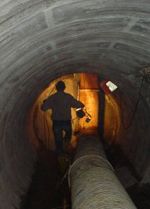We’re living in an age when facts don’t matter. Farhad Manjoo, in a thought-provoking new book, explains how modern media technology has exacerbated human tendencies to selectively absorb information that comports with our beliefs, and to screen out information that doesn’t jive with our version of “reality.” In a post-fact society, the line between what is fact and what is opinion has become blurred to the point of irrelevance.
We now conduct public debates without a base of verified, agreed-upon facts. While Manjoo uses sweeping national issues like global warming and the war in Iraq to demonstrate this, the lack of fact-based debate also shows up in questions of local infrastructure and services, where the public is called upon to decide how to invest public dollars to solve public problems.
It’s the dirty little secret of every city built on water that poo sometimes ends up in the water. Even in those places blessed with modern sewerage treatment, i.e., the developed world, poo still ends up in the water when it rains a lot. In old cities, where the storm and sanitary sewers run through the same lines, heavy rains can overwhelm the system, requiring the release of untreated wastewater into the waterways. It’s a problem that continues to plague cities throughout the developed world.
Modern engineering has hit upon an ingenious, though expensive, solution to this nagging problem: massive underground tanks that hold overflow wastewater until it can be treated, thus preventing its release into the waterways.
Milwaukee is one of the first large Great Lakes cities to adopt this technology. In the 1980s the Milwaukee Metropolitan Sewerage District (MMSD) embarked on a multi-billon dollar project, dubbed the Deep Tunnel, which essentially resulted in a series of massive tunnels bored deep beneath the city. These tunnels hold excess rainwater during heavy rains, wastewater that would have previously ended up in our rivers and Lake Michigan.
So how has the system performed? Here are some facts: Untreated wastewater overflows have declined from an average of 60 per year before the Deep Tunnel to 1.5 per year today. The volume of untreated wastewater dumped into the waterways has declined 80 percent since the Deep Tunnel went online. With the Deep Tunnel, Milwaukee today dumps a fraction of what other large Great Lakes cities do.
But these facts don’t matter. In a public sphere heavily influenced by talk radio and other media outlets, such as local blogs, where there is no clear line between fact and opinion, where outright falsehoods are presented as legitimate opinions, (often in the form of “regular joe“ commentary) the billons of dollars in investment in the Deep Tunnel are now deemed a massive waste.
The debate is not over whether the Deep Tunnel was worth the investment, whether its benefits have outweighed its costs. No, the rub is with whether or not the Deep Tunnel has been a public benefit. The fact that it does largely function as it was designed to is irrelevant. A large swath of the public believes it doesn’t work, and that MMSD has made the problem worse.
Back before the Deep Tunnel, sewerage overflows were a common occurrence and were rarely reported in the media when they happened. Now they are a rare occurrence, and so are widely reported when they happen. The public’s perception therefore, is that that sewerage overflows are a worse problem today than they were before the Deep Tunnel. Ironically, the project’s success has led to the perception that it’s been a failure. And since the public is predisposed to think that regional government agencies like MMSD are cash-eating monsters that not accountable to the taxpayers, in the public mind, MMSD has wasted our money on a boondoggle.
Add to that the periodic (and odoriferous) algae plumes that wash up on the shoreline, and beach closings that have been caused by unsafe levels of bird droppings in the water, and there’s little doubt in the public mind: MMSD not only wastes our money but also made the water dirtier.
Water pollution is a highly emotional issue, and the engineering behind the Deep Tunnel and wastewater treatment in general is highly complex. Public education is problematic on an icky topic that would take five minutes of tedious airtime to explain to the average TV viewer. How does MMSD explain the facts behind the Deep Tunnel when a much simpler and more sensational message resonates through the echo chamber of local media: “There’s poo in the water”?
The massive public investment in the Deep Tunnel has resulted in a public benefit: The water is noticeably cleaner. Fish species that haven’t been seen in the Milwaukee River in generations are repopulating, and bird species, such as blue heron, are returning. The urban Milwaukee River has seen over one billion dollars in residential development along its shores over the last ten years.
Indeed, Milwaukee’s system is often cited as a national model, and it’s not yet complete. When the final leg of the system is completed, the Deep Tunnel may very well make Milwaukee the first big city in human history to have essentially made the problem of poo in the water go away.
A public investment that nets public results: This is how it’s supposed to work, right? If only we could recognize the fact that the Deep Tunnel works, and finish job.













